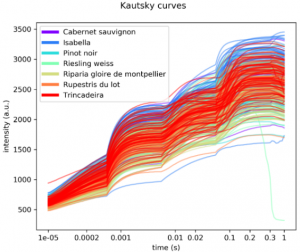
Jorge Marques da Silva, Andreia Figueiredo, Jorge Cunha, José Eduardo Eiras-Dias, Sara Silva, Leonardo Vanneschi, and Pedro Mariano
When a dark-adapted leaf is illuminated with saturating light, a fast polyphasic rise of fluorescence emission (Kautsky effect) is observed. The shape of the curve is dependent on the molecular organization of the photochemical apparatus, which in turn is a function of the interaction between genotype and environment. In this paper, we evaluate the potential of rapid fluorescence transients, aided by machine learning techniques, to classify plant genotypes. We present results of the application of several machine learning algorithms (k-nearest neighbors, decision trees, artificial neural networks, genetic programming) to rapid induction curves recorded in different species and cultivars of vine grown in the same environmental conditions. The phylogenetic relations between the selected Vitis species and Vitis vinifera cultivars were established with molecular markers. Both neural networks (71.8%) and genetic programming (75.3%) presented much higher global classification success rates than k-nearest neighbors (58.5%) or decision trees (51.6%), genetic programming performing slightly better than neural networks. However, compared with a random classifier (success rate = 14%), even the less successful algorithms were good at the task of classifying. The use of rapid fluorescence transients, handled by genetic programming, for rapid preliminary classification of Vitis genotypes is foreseen as feasible.
Doi: 10.3390/plants9020174
Cited as: Marques da Silva J, Figueiredo A, Cunha J, Eiras-Dias JE, Silva S, Vanneschi L, Mariano P (2020) Using Rapid Chlorophyll Fluorescence Transients to Classify Vitis Genotypes. Plants 9(2), 174; https://doi.org/10.3390/plants9020174.



